"Yours, Mine, and Ours…" The origin of the original blended American family At Naval Air Station Whidbey Island, Washington 7 June 1960 In the 1968 film, "Yours, Mine, and Ours," Helen North (played by actress Lucille Ball) states that she is a widow, her husband having died on a routine training flight. Sometimes, in storytelling, epic personal tragedies are reduced to a single line of dialogue. The commonplace practice keeps the story moving without getting bogged down in uninteresting exposition. But the story not told is one that should be. 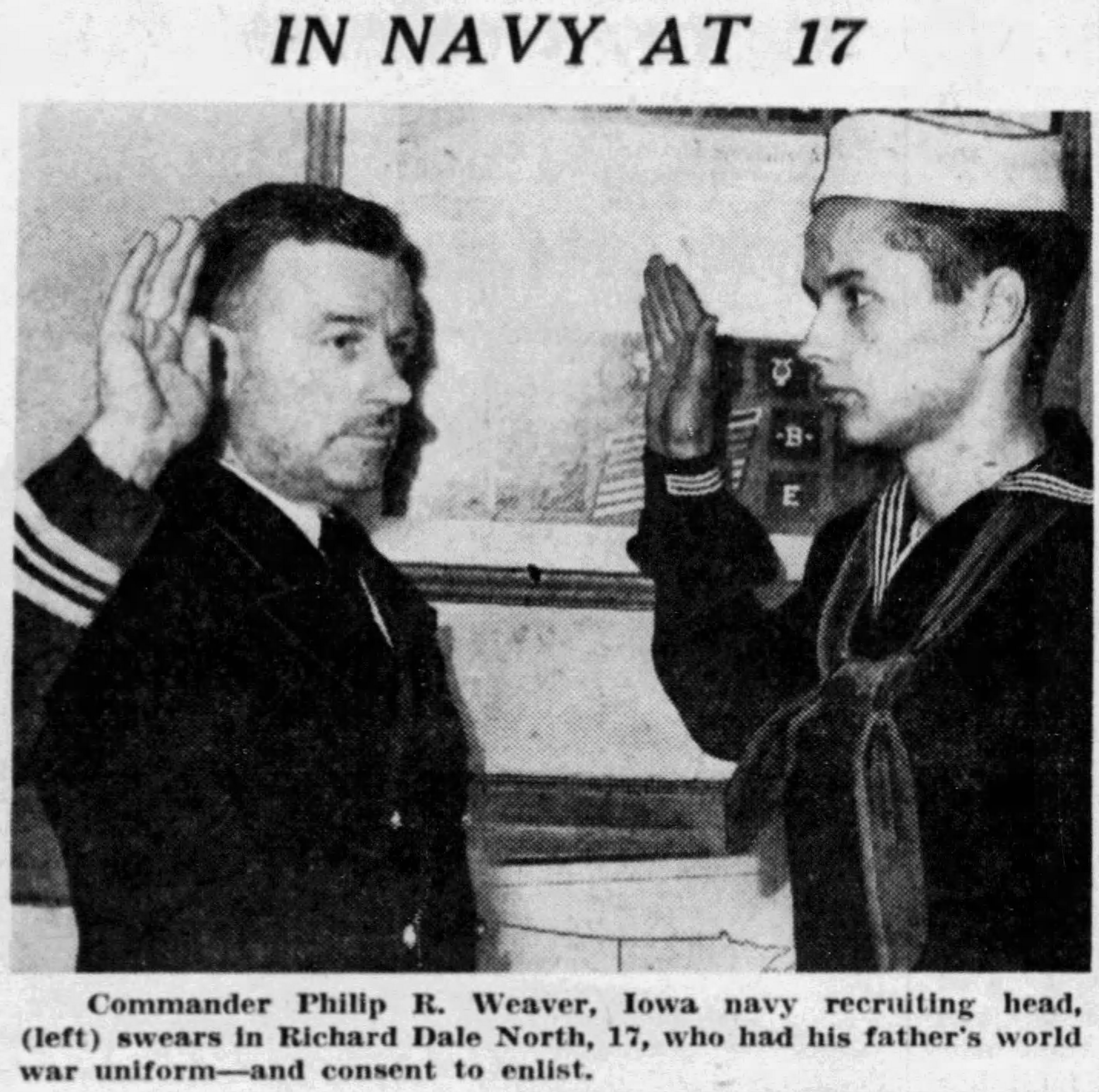 Richard Dale North was born August 22, 1924, in Mineral Wells, Texas. Five days after the Japanese attack on Pearl Harbor and the United States entered the second World War, on December 12, 1941, the tall and slender 17-year-old theatre usher North enlisted in the Navy in Des Moines, Iowa, and was sworn into the service wearing his father’s naval uniform from the first World War. “Dad enlisted in the navy in this same office during the other war," he said regarding the occasion. After graduating from East High School, he went to training at Naval Air Station Jacksonville, Florida, where he became a bomb and weapons loader, first serving at the Naval Proving Grounds in Dahlgren, Virginia, and the U.S. Naval Base at Walker's Cay, the northernmost island in the Bahamas. At the beginning of 1944, he joined Naval Bomber Squadron 15 (VB-15), first aboard the aircraft carrier USS Hornet (CV-12) and then to the USS Essex (CV-9). His squadron, flying Curtiss SB2C Helldivers, was part of Carrier Air Group 15 (CVG-15), led by legendary Commander David McCampbell, who would become the Navy’s leading ace in World War II with thirty-four kills and was awarded the Medal of Honor for heroism. The year 1944 would see the CVG-15 fight in the battles of the Philippine Sea (a.k.a. the “Marianas Turkey Shoot”), strikes on the Japanese-held island of Formosa, and the most massive naval battle in history - Leyte Gulf in the Philippines. 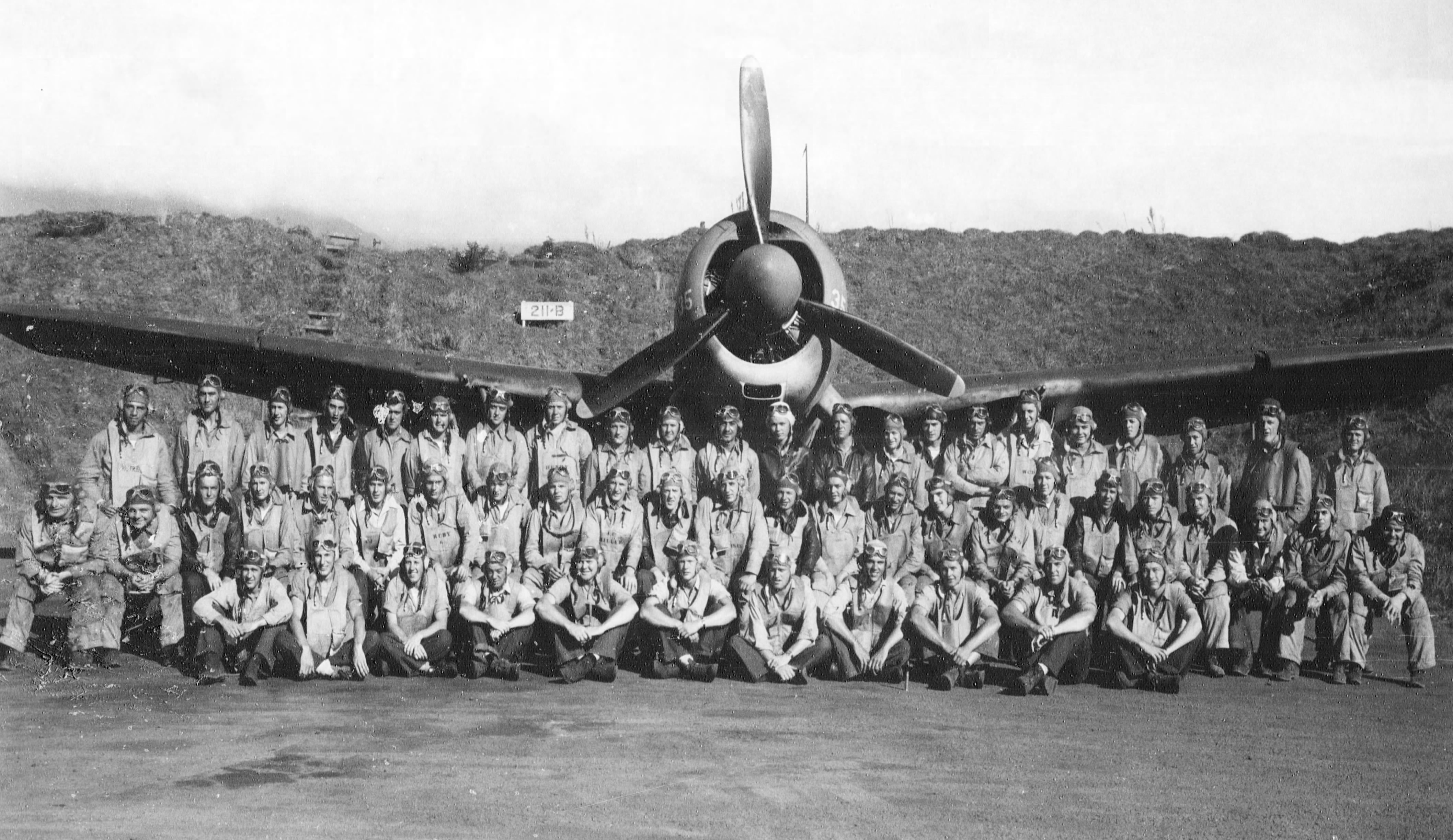
Bombing Squadron (VB) 15 combat aircrewmen and crew, NAS Puunene, Maui, T.H., April 1944 - North is sitting in the front row, third from the right.By the time the war ended, both North’s father and older brother had enlisted as well, plus his sister DoraMay flew aircraft as part of the Civilian Air Corps and Women's Auxiliary Ferrying Squadron. Richard himself had been promoted to Chief Aviation Ordnanceman but continued to serve in the Navy. In a Catholic service at the Church of Saint Joseph in Seattle, on July 30th, 1949, he married Helen Eileen Brandmeier, who studied nursing at Seattle University. Just under a year later, on June 1, 1950, the couple’s first child – a daughter - was born in Oak Harbor, Washington. 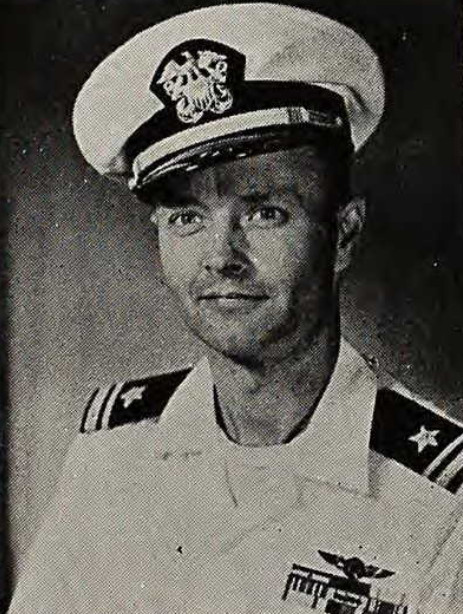 And the following year, another daughter, was born in Kodiak, Alaska. And a son the year after, and another the year after that back in Washington. The family moved to the Japanese island of Okinawa, where another daughter was born. Then the family move to Illinois and, in 1957 welcomed another boy into it. After the senior North finished training there, he and the family returned to Washington state, where another son joined the family. Two months after the birth of their 7th child - on December 25th, 1958 – he was promoted to Lieutenant (Junior Grade). But when Helen revealed she was pregnant with their 8th child, Richard North realized that this career of flying high-performance military jets was growing increasingly incompatible with his still-growing family. 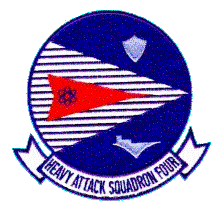 In late April of 1960, while assigned to the Heavy Attack Squadron 4 (VAH-4) and flying Douglas A3D-2 “Skywarrior” bombers, he asked to be removed from flight status and to be given a desk assignment. In late April of 1960, while assigned to the Heavy Attack Squadron 4 (VAH-4) and flying Douglas A3D-2 “Skywarrior” bombers, he asked to be removed from flight status and to be given a desk assignment.
Furthermore, he was losing confidence in the piloting abilities of his crew leader - who had just recently transitioned from F9F Panthers to the far-more powerful A3D - as well as the overall capabilities of the aircraft design itself. However, his commanding officer, Commander John J. Emanski, refused North’s reassignment – he was too important to the squadron’s mission and he could not let the vast experience go to waste at a desk.
June 7th, 1960 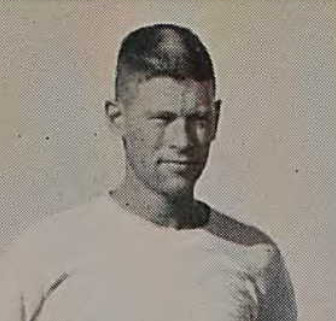 Typically, the Skywarrior carries three crew, but on this flight – a fourth crewman was aboard to get some flight time. With clear skies, the crew aboard A3D bureau number 138970 that day had 35-year-old Lt Commander Howard Bradford “Buzz” Moore assigned as the pilot. The 1948 graduate of the U.S. Naval Academy at Annapolis, and veteran of both World War 2 and the Korean War, he was the father of 2 children. North was assigned the position of bombardier-navigator, while Ensign Howard P. Lambert, 25, of Johnston, Pa., sat in the 3rd seat as North’s backup. An enlisted electrical technician, George W. Mozier, 28, sat in the 4th seat for what was intended to be a scheduled high-altitude radar bombing training flight at the Boardman Bombing Range in Morrow County, Oregon. Moore, North, and Mozier had been a crew about two months at that point - albeit Mozier was a last-minute replacement for another crewman, while Lambert had recently joined the squadron and was in need of practice. Shortly after noon, Moore lined up on Runway 24 for takeoff, spooled up the jet’s two Pratt & Whitney J57-P-10 turbojet and the 35-ton “Whale” – as it was nicknamed by maintenance crews – barreling down the pavement. But, as it picked up speed and energy, and without warning - the starboard engine flamed out. Without thinking, Moore immediately acted - slamming on the plane's rudder pedals causing the wheels to lock. A tire on the plane’s starboard landing gear blew, rocking the bomber’s airframe and with less than 3000 feet of runway remaining, Moore reduced cut the power to the port engine and announced he was aborting the takeoff. Shooting past the runway's arresting wire, and had no choice left but to commit to a partial-power climb and land. But the aircraft's controls became ineffective as it lost speed. It craft barreled off straight out from the runway into the rough and plowed toward the waters ahead. At high speed, it launched itself off of the seawall, plunging into Puget Sound 200 feet from the shore of Whidbey Island, sinking in the shallow waters. The impact gutted the cockpit, which Lambert and Mozier escaped – being torn clear from the wreck in the impact. Albeit both injured, they were rescued by a helicopter within 10 minutes of the crash and taken to the naval hospital in Bremerton. Moore and North, however, were both fatally injured. North was buried a week later in Willamette National Cemetery (Section T, plot 1711) in Portland, Oregon, and Moore was interred at Barrancas National Cemetery (Section 27, plot 163) in Pensacola, Florida. The navy's accident investigation uncovered that Moore mistaken cut power to the left engine when his right engine failed. The error was compounded by him failure to deploy the tail hook to grab the arresting cables and the assumption he still had a thrust-producing engine with which to climb. As a result of this mishap, the accident board recommended that the Navy shift its emphasis from broad-based aircraft training to more focusing more on specific procedure and emergency training and qualification for particular aircraft models - a practice still in use today. The wreckage of the Skywarrior was salvaged for parts and was scrapped afterward.
Aftermath North’s widow, Helen, gave birth to the couple’s 8th child a few months later and she, with her eight children, moved to San Leandro, California, a few months after that. She enrolled her school-age children in parochial school and found refuge in her Catholic faith. Helen was then introduced to the brother of a nun she had been counseled by, and the two – both having endured the loss of a spouse – struck up a relationship via mail. The 45-year-old widower, Navy chief warrant officer Francis “Frank” Beardsley, had lost his wife, Frances, to a diabetic coma. The sailor has also served during World War II, first aboard the battleship Iowa and eventually promoted to administration and personnel positions at the Naval Postgraduate School in Monterey. A native of San Francisco, he was also the father of 10 children. After a quick courtship, the two decided to merge their families – culminating in their wedding on September 9th, 1961, in the chapel of the Mission San Carlos Borromeo de Carmelo in Carmel, California. The couple sold the San Leandro home and added-on to Beardsley’s home on Rio Road in Carmel. There, to the outside world, the family of 20 projected an air of wholesomeness and love. News of the large family spread, and an advertising firm put the family in a commercial for the Langendorf Bread Company, which earned them royalties and 50 free loaves of bread every two weeks for a year. By 1964, the Beardsleys had two additional children of their own, bringing the final total to 22 in the family. Helen Beardsley proceeded to write a book about their new family’s early years, "Who Gets the Drumstick?", which became a bestseller and led to the 1968 movie starring Lucille Ball and Henry Fonda entitled “Yours, Mine, and Ours.” The movie was (very loosely) remade in 2005 starring Rene Russo and Dennis Quaid. Beardsley retired from the Navy in 1968 and the family then operated "Ye Olde Donut Shop and Morrow's Nut House" in Monterey. Frank and Helen later retired from that and moved to Fresno in 1973, where she became a cardiovascular technologist at a local hospital. Retiring a third time, they subsequently moved to Santa Rosa in 1986. Helen died in April of 2000, at the age of 70. Frank later remarried, and he passed away in 2012. |
